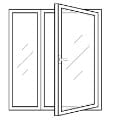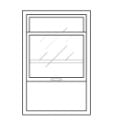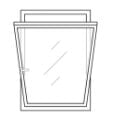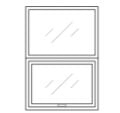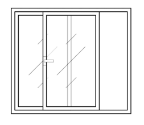Condensation on windows is a common issue. Here, we explain how to prevent and reduce condensation on your windows, in both winter and summer.
Why causes Condensation on Windows?
Condensation naturally forms on windows in winter. This happens due to the contrast between the cold air outside and the warm, humid air inside our homes.
You might also see condensation in summer when cold beverages cause moisture to form on the outside of a glass.
While condensation may look unattractive, it’s not necessarily a problem. In fact, especially in new homes, it’s often a good sign. Condensation in winter can indicate that your window seals are working well, keeping outside air out and maintaining indoor humidity for a comfortable home.
Condensation tends to form on glass or metal surfaces, which conduct temperature changes rapidly.
Different Types of Condensation on Windows
Condensation can appear on different parts of the window, each with different implications. Here’s an overview of common types of window condensation.
Condensation on the Outside of Windows
Condensation on the outside of your windows isn’t a concern. It’s caused by warm air meeting cold glass and typically fades as the temperature balances out.
Condensation Inside Windows
Inside, condensation often results from daily activities like cooking or showering. It usually clears up on its own and doesn’t indicate any major issue.
Condensation Between Window Panes
Condensation between panes can indicate a problem, like a frame seal leak. If this happens with your windows, we recommend you contact us to assess the situation.
When Should You Be Concerned?
Some condensation on windows is normal. However, if you start noticing mold forming, or if the fogging doesn’t clear up after wiping, it’s time to act. This can signal high humidity levels in your home, which could lead to long-term issues for your home’s structure and interiors.
Managing Indoor Humidity: Temperature and Humidity Guide
to reduce window condensation in winter, it’s essential to monitor and regulate indoor humidity. Use a hygrometer to measure your home’s humidity levels.
Here’s a quick guide to recommended relative humidity levels based on outdoor temperatures. These guidelines can help you adjust indoor humidity, minimizing condensation and frost on your windows to ensure clear views and a healthy living environment.

Causes of Window Condensation
There are several causes of condensation on windows. Here are a few:
Household Activities
Everyday activities like showering, doing dishes or laundry, and cooking contribute to increased humidity.
Pets and Plants
Pets, indoor plants, and even fish tanks can increase ambient humidity.
Ventilation and Appliances
Improperly set humidifiers can add too much moisture, and a dryer not vented to the outside can also elevate indoor humidity.
Home Structure
A damp basement or crawl space with an unsealed earth floor can contribute to high indoor humidity.
Blocked Ventilation
Indoor drying clothes, along with closed blinds or curtains, can restrict airflow and increase window condensation.
How to Prevent Condensation on Windows
Your windows aren’t just for looking outside—they can also signal when it’s time to take action for a healthier indoor environment.
When you see condensation on your windows, it might mean that indoor humidity is too high. Here are some simple tips to help prevent costly complications.
Open Up Your Windows
Before winter arrives, remove window screens. This allows better air circulation, reducing condensation buildup.
Let Light and Air in
Avoid keeping blinds or curtains closed all day or night. Open them periodically to warm the window glass and reduce fogging.
Watch Your Greenery
Too many indoor plants can increase humidity. If you love plants, try keeping fewer or ensure they aren’t over-watered.
Check Your Appliances
Make sure your dryer vents to the outside without leaks to avoid excess humidity indoors.
Store Firewood Outside
If you use firewood for heating, keep it outside to prevent indoor moisture buildup.
Ensure Good Ventilation
Use bathroom fans and range hoods when needed. This helps clear out moisture generated from everyday activities.
Reduce Shower Time
Shorter showers can help reduce humidity. It’s also better for the environment and your electricity bill!
Optimize Heating
Place a heat source near windows. This helps warm the glass and reduce condensation.
Adjust Humidity Levels
When winter cold sets in, check and adjust indoor humidity before raising the heat. This can improve efficiency and comfort.
Balance Room Temperatures
During heating season, ensure consistent temperatures across rooms to avoid condensation-prone areas.
Encourage Airflow
When possible, keep doors open between rooms to allow effective air circulation throughout your home.
Air Out Strategically
On milder winter days, open windows to let in dry outdoor air and allow excess moisture to escape.
Heat the Basement
Don’t forget to heat the basement. It helps warm upper floors and prevents excess humidity from building up.
Removing Condensation with a Dehumidifier
Using a dehumidifier is an effective way to reduce excess indoor humidity and, as a result, condensation on your windows.
A dehumidifier works by pulling in moist air, cooling it to condense moisture, then warming it up again before releasing it back into the room. This lowers humidity levels and reduces the chance of condensation and mold.
For best results, place your dehumidifier in areas with high humidity, like the kitchen, bathroom, or basement. Choose a model suited for your space’s size and empty it regularly.
How to Prevent and Stop Condensation on Windows: In Summary
While condensation on windows might seem like an issue, it’s a valuable indicator of indoor humidity levels.
By adjusting ventilation, monitoring humidity levels, and using simple methods like regular airing and a dehumidifier, you can effectively reduce condensation.
By following these tips, you’ll not only protect your windows but also create a healthier, more pleasant living environment while minimizing the risk of mold and damage.
Stay proactive and follow these steps to prevent, stop, or reduce condensation on your windows. And if you have any questions, feel free to get in touch with us!



